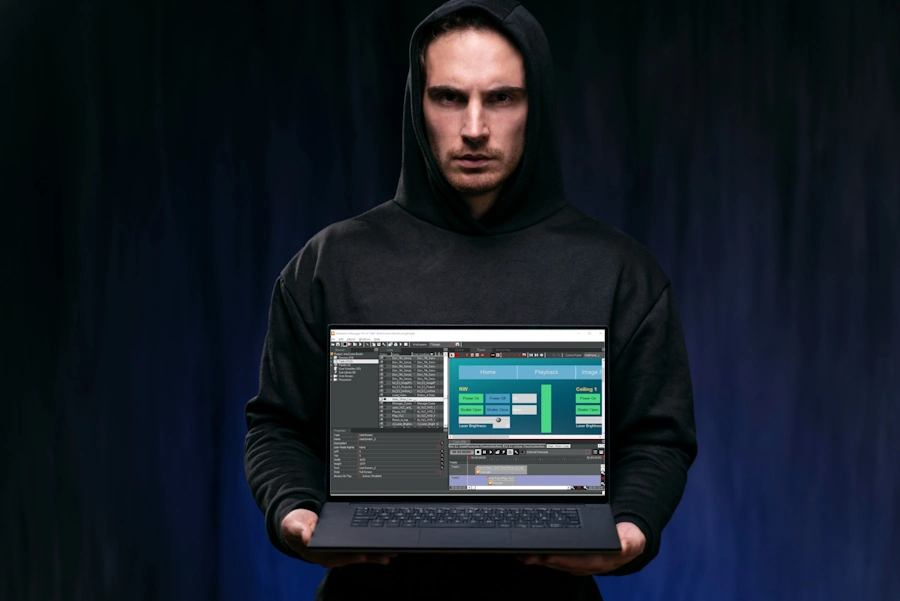As a show and ride systems engineer, I am often the last one in and the last one out of a themed entertainment project. While I stress to many of my clients the need for show control systems to be considered early in the development progress, its importance is often underestimated or forgotten entirely until very late in the project timeline. This is mainly due to a lack of understanding of show control and its importance in a consistent and engaging guest experience. To help understand show control, we’ll explore the many aspects of this important system.
What is Show Control?

Show control in themed entertainment refers to the technical and logistical management of various elements within an entertainment experience, such as theme park attractions, theater productions, multimedia installations, museum exhibits, and other immersive environments. It involves the coordination and synchronization of multiple audio, visual, lighting, special effects, animatronics, and mechanical systems to create a seamless and captivating experience for the guest.
Show control systems are typically computer-based and allow operators to control and monitor various elements of the show in real time. These systems can be programmed to trigger specific events, cues, and sequences at precise moments, ensuring that the performance or experience unfolds as intended.
Some key aspects of show control in themed entertainment include:
- Automation: Show control systems automate the operation of various components, ensuring that everything happens precisely as planned. This might involve triggering sound effects, moving animatronic characters, adjusting lighting, or initiating video projections at specific times.
- Synchronization: In many themed entertainment experiences, multiple elements need to work together to create a coherent narrative. Show control systems ensure that different elements – such as audio cues, visual effects, and physical movements – are perfectly synchronized to enhance the overall impact.
- Interactive Elements: Some show control systems are designed to respond to guest actions or input. For instance, in interactive attractions, the system might adapt the show’s progression based on the choices made by guests, making each experience unique.
- Integration: Show control systems often need to integrate with various technologies, such as audio systems, video playback devices, lighting consoles, motion control systems, and more. Seamless integration ensures a unified performance.
- Safety: Show control systems also play a role in ensuring the safety of both performers and guests. For example, safety sensors might be integrated into animatronics or stage setups to prevent collisions or other hazards.
- Monitoring and Diagnostics: Show control systems provide operators with real-time feedback and diagnostics, allowing them to identify and address any technical issues that may arise during a performance or attraction operation.
- Programming and Scripting: Creating a show control system involves programming and scripting to define how different elements interact and when they are triggered. This requires a combination of technical expertise and creative understanding to deliver a captivating experience.
In essence, show control is the behind-the-scenes technology that brings the magic of themed entertainment to life. It enables creators to design and deliver captivating experiences that transport guests into different worlds, whether it’s a thrilling roller coaster, an immersive museum exhibit, a theatrical production, or any other form of live entertainment. It ensures that all the technical elements work together harmoniously, enhancing the overall impact and enjoyment of themed entertainment attractions.
Why Show Control is Important

Very often, the importance of show control gets overlooked or forgotten. This is mainly due to a lack of understanding or experience when it comes to the final integration of a complex show or attraction. Show control is important in themed entertainment for several key reasons:
- Seamless Immersion: Themed entertainment experiences aim to transport guests into different worlds and narratives. Show control ensures that all technical elements, such as lighting, audio, video, effects, and animatronics, work harmoniously together, creating a seamless and immersive environment that enhances the guest’s suspension of disbelief.
- Enhanced Storytelling: Show control technology allows for precise timing and synchronization of various elements. This precision is crucial for delivering the storyline as intended by the creators. Timed effects, audio cues, and visual elements can all contribute to the narrative, making the experience more engaging and impactful.
- Guest Engagement: Immersive attractions often involve interactivity, where guests’ actions influence the experience. Show control systems enable the attraction to respond to these interactions in real time, providing a personalized and engaging experience that encourages repeat visits.
- Awe and Amazement: Themed entertainment experiences are designed to evoke emotions and create memorable moments. Show control technology enables the execution of stunning visual and auditory effects that can awe and amaze guests, leaving a lasting impression.
- Technical Complexity: Many attractions involve a multitude of technical components, such as moving parts, lighting changes, and special effects. Show control simplifies the management of these complex elements, ensuring they work together seamlessly without overwhelming the attraction operators.
- Safety and Reliability: Show control systems often include safety features that can immediately halt the attraction or show in case of emergencies. These systems are designed to prioritize guest safety while also ensuring the reliability of the attraction’s operation.
- Consistency: Themed entertainment attractions aim to provide consistent experiences to all guests. Show control ensures that every performance or ride is consistent in terms of timing, effects, and overall quality, regardless of external factors or human error.
- Operational Efficiency: Show control technology streamlines the management of attractions, reducing the need for manual intervention and minimizing the risk of technical glitches. This efficiency allows attraction operators to focus on guest experience and safety.
- Guest Appeal: In today’s tech-savvy world, guests have come to expect highly sophisticated and interactive experiences. Show control technology helps attractions stay relevant and appeal to modern audiences by offering cutting-edge experiences.
- Differentiation: Themed entertainment is a competitive industry. Attractions that utilize advanced show control technology can stand out from the competition, offering unique and compelling experiences that draw visitors and generate positive word-of-mouth.
In summary, show control is essential because it serves as the backbone of themed entertainment experiences. It brings together the creative vision, technical expertise, and operational considerations to create captivating and immersive attractions that enthrall guests and leave a lasting impression.
Why Show Control is Often Overlooked

While show control is a critical aspect of themed entertainment, it can sometimes be overlooked or forgotten for these reasons:
- Lack of Awareness: Some project stakeholders, especially those who are more focused on creative or thematic aspects, might not fully understand the technical complexities and importance of show control in delivering a seamless and immersive experience.
- Budget Constraints: Themed entertainment projects often have multiple competing priorities for budget allocation. Show control systems, which involve specialized technology and expertise, can sometimes be perceived as costly, leading to decisions to cut back on this aspect of the project.
- Focus on Front-End Elements: During the initial phases of a themed entertainment project, there’s often a strong emphasis on the design and theming of the attraction itself. Show control, which operates behind the scenes, might not receive the same level of attention as the visible and tangible elements of the experience.
- Late Integration Planning: If show control is not considered and planned for from the project’s inception, it can lead to a situation where its importance becomes apparent only in the later stages. By this point, it may be challenging to allocate sufficient time and resources for its proper implementation.
- Communication Gaps: Show control requires close collaboration between creative, technical, and operational teams. If there are communication gaps between these teams, show control requirements and considerations can easily be overlooked.
- Changing Priorities: Themed entertainment projects can be complex and subject to changes in priorities, creative direction, and scope. These shifts can lead to a lack of focus on show control if it’s not given consistent attention throughout the project’s development.
- Perception of Non-Criticality: Some stakeholders might perceive show control as a “nice to have” rather than a critical aspect of the guest experience. This mindset can lead to show control being sidelined or minimized.
- Lack of Expertise: If the project team lacks experience or expertise in show control and its related technologies, they may not fully grasp its importance or the potential challenges it can pose.
To avoid the issue of show control being forgotten or overlooked, it’s crucial to:
- Educate all stakeholders about the role and significance of show control in creating a successful themed entertainment experience.
- Integrate show control planning into the early stages of the project, ensuring that technical and creative teams work together to define requirements and align on expectations.
- Allocate appropriate budget and resources for show control development, testing, and integration.
- Foster open and clear communication between all teams involved in the project to ensure that show control is a continuous consideration.
- Build flexibility into the project timeline to accommodate show control development and testing.
By recognizing the value of show control and integrating it into the project from the beginning, themed entertainment experiences can be more immersive, engaging, and successful overall.
Why Show Control is Always Last

As I mentioned earlier, the show control team is generally the last to finish up on a themed entertainment project. This is not always because it has been overlooked. Show control is often left to the later stages of a themed entertainment project for a multitude of reasons:
- Integration Complexity: Show control involves coordinating and synchronizing various technical elements, such as audio, video, lighting, effects, and animatronics. These components are often developed separately by different teams or vendors. Integrating these diverse elements can be complex, and it’s more efficient to focus on their individual development first before tackling the intricacies of synchronization.
- Iterative Design Process: Themed entertainment projects often go through an iterative design process. The creative concept evolves as the project develops, and changes might be made to the show’s narrative, timing, or effects. Starting show control too early could lead to unnecessary rework if the creative direction changes during the project’s development.
- Technical Readiness: Before show control systems can be designed and implemented, the technical specifications of the various show elements need to be finalized. This includes the specifics of audio systems, lighting fixtures, video playback devices, animatronics, and special effects. Waiting until these technical details are settled ensures that the show control system can be tailored to the actual equipment and technologies being used.
- Testing and Refinement: Once all the individual components are ready, show control can be introduced to bring them together for testing and refinement. This stage involves ensuring that everything works seamlessly, timings are precise, and interactions are smooth. Starting this process earlier could result in constant adjustments as different components are developed and fine-tuned.
- Operational Considerations: Show control systems are closely tied to the operational aspects of a themed attraction. This includes safety protocols, emergency shutdown procedures, operator training, and maintenance procedures. Addressing these operational considerations is typically more effective once the core creative and technical elements are in place.
- Resource Allocation: Show control development requires specialized expertise in programming, system integration, and technical coordination. Allocating these resources to show control early on might detract from other critical aspects of the project’s development, such as conceptual design, attraction layout, theming, and content creation.
- Prioritization: During the earlier stages of a project, the focus is often on developing the core features and ensuring the overall design aligns with the creative vision. Show control, while essential, is seen as a tool to enhance the final experience and is prioritized as the project matures.
It’s important to note that while show control may be left to the later stages, it should still be considered and planned for from the project’s inception. The creative and technical teams need to collaborate closely to ensure that the show control requirements are integrated into the overall design and development process. This approach helps avoid potential conflicts or challenges down the line and ensures a smoother transition to the show control implementation phase.
Conclusion
Show control in themed entertainment is often overlooked or underestimated and pushed to the end of the project. Stakeholders need to understand its importance and consider the requirements from the early stages of development, including the initial budget and schedule phases. The earlier that technical and non-technical teams concisely communicate the intent of the experience, the better that show control integration is achieved efficiently and can enhance guest engagement.
Featured image by Freepik. Laptop screen Modified.
Schedule image from Free Stock photos by Vecteezy
Share this Post

